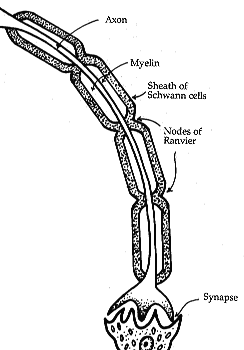 |
Neuron - Meylin
The disease multiple sclerosis involves random attacks on the fatty material of the central nervous system called myelin. Myelin covers the axon structure of nearly all neurons, and is a fatty white substance that exists in structures that make up the brain and spinal cord (Gertz). Myelin is a vital element in the central nervous system. It must be present in order for nerve impulses to be propagated to the next neuron (Gertz). Without the myelin, nerve signals become slowed, garbled, or completely blocked causing the symptoms of MS. This can be easily seen in infants. The myelin in the infants has not been completely laid down. The process of laying down myelin is known as myelinaization, and when completed is one of the factors in the child learning to walk (Gertz). The myelin can be considered to be the insulation on an electrical wire, it insures the signal is transmitted. With MS, damage can come at any point along the brain and spinal cord, and can occur at any time (Minden).

The myelin sheath is not a continuous layer over the axon, but have gaps and a overlying cover. The breaks in the myelin sheath are called the nodes of Raniver, and provide support for the axon. The cover is called the Sheath of Schwann, this holds specialized cells called oligodendroglia cells. These specialized cells form the myelin sheath surrounding the axon using two principal proteins, the myelin basic protein and proteolipid protein (Gertz). Research has been able to identify that with MS certain cells from the immune system, called T-cells become sensitized to myelin basic protein and begin to attack it. When the myelin is attacked, the body tries to make some repairs. In the initial phases of multiple sclerosis, the oligodendroglia cells are not destroyed, and begin to produce more myelin (LaRoca). This causes the symptoms of MS to disappear until the myelin degenerates again. The later stages of multiple sclerosis often accompanies the loss of the oligodendroglia cells, and eventually with or without the specialized cells, a person with MS develops areas of scarring where healthy myelin once was (Gertz). This is where multiple sclerosis finds its name, from the multiple scarring, or sclerosis, on neurons found in the brain or spinal cord (Minden).
|
|
![]()